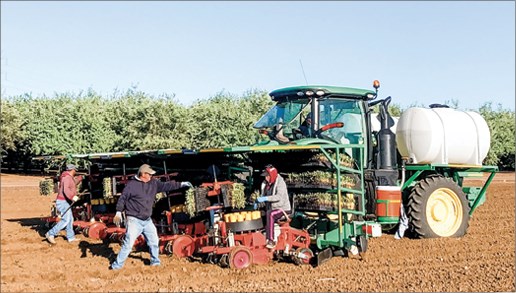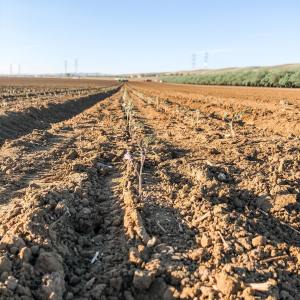The 2020 tomato crop is being planted into a world of uncertainty as the global pandemic adds turmoil to tomato season.
“I guess we’re gambling right now,” said Aaron Barcellos, who grows processing tomatoes in Merced and Fresno counties. “We’re rolling the dice that it’s all going to be fine by August, when we start harvest.”
The U.S. Department of Agriculture’s January forecast called for 12 million tons of processing tomatoes on 235,000 acres, the tonnage being virtually unchanged from 2019. The COVID-19 pandemic, however, has thrown markets into turmoil.
“We walk into stores as growers and see there’s not any canned tomato products or pasta sauces or any of that stuff on the shelf,” Barcellos said. “So we expect demand to pick up on that side. But we also know the food-service side has been hit pretty hard.”
Processors packaging for retail “have been extremely busy recently,” said Don Cameron, a diversified grower in Fresno County. “You just don’t shift from one to the other. Your processing facility is set up maybe for bulk paste or diced product, but not typically for the retail business.”
Processors serving food-service businesses, he said, are trying to gauge how the pandemic will play out.
“How long are these restaurants and schools going to be closed?” Cameron said. “The food-service side is just kind of an unknown right now.”
Mike Montna, chief executive of the California Tomato Growers Association in Sacramento, said “there’s no historical context for our people to go off of.” He’s assessing daily what the overall impact will be, which he described as “a shift on how we’re eating our meals and where we’re getting them.”
“I think everyone’s trying to understand, how long are these changes going to be in place?” Montna said. “What do the markets look like when they come back?”
Companies are working with historical sales data and updating models based on the best available information, he added.
Tomato growers also have been taking extra precautions on the farm.
Barcellos’ tomato planters have employees sitting 5 feet apart. As social-distancing guidelines call for 6 feet of separation, the farm has installed plexiglass dividers between the seats.
Barcellos also has been staggering start and break times, in addition to ensuring his employees have masks, gloves and information, he said, “making sure they feel safe coming to work, making sure they understand that they’re essential, making sure that we’re providing them with all the training they need.”
That extends to after-hours activities as well, he noted.
“Many of our workers are living in close quarters, and we don’t know what happens when they go home and who they’re exposed to as well,” Barcellos said. “So we’ve been trying to educate them about that and making sure they’re reducing their exposures and risks as much as possible.”
Cameron said his safety precautions include the farm office as well. Only one staffer is on duty at the office at a time, with the others working from home; paperwork and parcels are dropped off outside and wiped down before being brought in.
“I’ve been wearing my mask, too,” Cameron said. “We changed the shift times so that we have our irrigators coming at one time, and we have our tractor drivers coming in at another time, and our office staff so that we don’t have large groups of people together at one time.”
“We have a full crew out here,” he said. “They understand the severity of the problem, and they’re being vigilant. The last thing we want to have is a problem on farm with our workforce. We want to keep everybody healthy and safe as possible. We rely on the workforce. Without them, we’re done.”
Russell van Loben Sels, who grows tomatoes in Sacramento County, said much of the work at his place is socially distanced already.
“One guy, one tractor, no riders,” he said. “We’re sort of lucky in that way, that most of our activities are by a single individual.”
Farmers said planting has not been hindered much.
“Our planting is on schedule, although the recent rains have slowed everything down,” Cameron said.
Lance Dami, who works in field operations and customer service at Los Gatos Tomato Products in Huron, said planting around the Bakersfield area began around Feb. 17, “which is normal for us,” although recent rains set planters behind by about a week. “It’s actually been a really smooth planting year,” he added.
With south-of-delta growers looking at a 15% water allocation from the federally operated Central Valley Project, Dami said contracted tomato acreage could shrink from 235,000 tons to about 230,000.
“There might be some growers cutting back on acres because of the cost of water,” he said.
Barcellos said he’s adjusted his acreage based on the water allocation, but otherwise he’s going full bore.
Van Loben Sels, whose fields lie near the Sacramento River, plans to start planting around mid-May.
“For us, it’s going to be a much easier season than last year,” van Loben Sels said. “In the delta, it’s always easier to farm when it’s a dry year. We don’t have high groundwater that’s associated with the river and high flows. So I assume it’s going to be a fairly orderly process once we get there.”
He’s talked to his processors, and plans to grow his normal acreage, he added.
Barcellos said he’s talked about the what-ifs inherent in the pandemic—”what happens if processors have to shut down or can’t run at full capacity, and we’ve got a perishable crop out there in the field,” he said. But so far, his processors are looking for the tonnage he plans to produce.
“Most of us farmers are optimists, and usually after tough times come good times,” Barcellos said. “So we’re looking forward to those days.”
Article courtesy of the California Farm Bureau Federation
Main image: Kevin Hecteman, AgAlert


Recent Comments